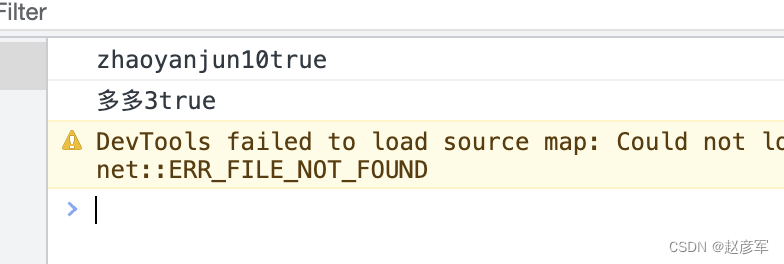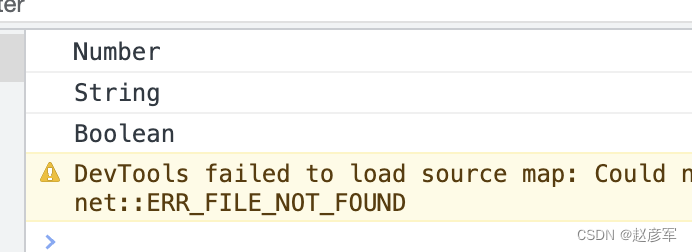-
Html第4集:对象定义、typeof、instanceof、undefine
转载请标明出处:http://blog.csdn.net/zhaoyanjun6/article/details/126503402
本文出自【赵彦军的博客】简单对象
<!DOCTYPE html> <html lang="en"> <head> <meta charset="UTF-8"> <title>测试</title> <script> //定义对象 user = {name: "zhaoyanjun", age: 10, man: true} //日志 console.log(user.name + user.age + user.man) //对象赋值 user.name = "多多" user.age = 3 //日志 console.log(user.name + user.age + user.man) </script> </head> <body> </body> </html>- 1
- 2
- 3
- 4
- 5
- 6
- 7
- 8
- 9
- 10
- 11
- 12
- 13
- 14
- 15
- 16
- 17
- 18
- 19
- 20
- 21
- 22
- 23
- 24
- 25
- 26
- 27
- 28
效果:

跨行定义对象
定义 JavaScript 对象可以跨越多行,空格跟换行不是必须的:
<!DOCTYPE html> <html lang="en"> <head> <meta charset="UTF-8"> <title>测试</title> <script> //定义对象 user = { name: "zhaoyanjun", age: 10, man: true } </script> </head> <body> </body> </html>- 1
- 2
- 3
- 4
- 5
- 6
- 7
- 8
- 9
- 10
- 11
- 12
- 13
- 14
- 15
- 16
- 17
- 18
- 19
- 20
- 21
- 22
输出对象属性:
console.log(user.name) console.log(user["name"])- 1
- 2
typeof
<!DOCTYPE html> <html lang="en"> <head> <meta charset="UTF-8"> <title>测试</title> <script> console.log(typeof 1) console.log(typeof 2.3) console.log(typeof "abc") console.log(typeof false) console.log(typeof [1, 2, 3]) console.log(typeof {name: "zyj"}) </script> </head> <body> </body> </html>- 1
- 2
- 3
- 4
- 5
- 6
- 7
- 8
- 9
- 10
- 11
- 12
- 13
- 14
- 15
- 16
- 17
- 18
- 19
- 20
- 21
- 22
日志:

instanceof
<!DOCTYPE html> <html lang="en"> <head> <meta charset="UTF-8"> <title>测试</title> <script> a = new Number(1) if (a instanceof Number) { console.log("Number") } b = new String("abc") if (b instanceof String) { console.log("String") } c = new Boolean(false) if (c instanceof Boolean) { console.log("Boolean") } </script> </head> <body> </body> </html>- 1
- 2
- 3
- 4
- 5
- 6
- 7
- 8
- 9
- 10
- 11
- 12
- 13
- 14
- 15
- 16
- 17
- 18
- 19
- 20
- 21
- 22
- 23
- 24
- 25
- 26
- 27
- 28
- 29
- 30
- 31
- 32
- 33
日志:

undefined
在 JavaScript 中, undefined 是一个没有设置值的变量。
typeof 一个没有值的变量会返回 undefined。
<!DOCTYPE html> <html lang="en"> <head> <meta charset="UTF-8"> <title>测试</title> <script> //没有定义 a </script> </head> <body> </body> </html>- 1
- 2
- 3
- 4
- 5
- 6
- 7
- 8
- 9
- 10
- 11
- 12
- 13
- 14
- 15
- 16
- 17

undefined 和 null 的区别
null 和 undefined 的值相等,但类型不等:
typeof undefined // undefined typeof null // object null === undefined // false null == undefined // true- 1
- 2
- 3
- 4
1、比较
(1)undefined:是所有没有赋值变量的默认值,自动赋值。
(2)null:主动释放一个变量引用的对象,表示一个变量不再指向任何对象地址。2、何时使用null?
当使用完一个比较大的对象时,需要对其进行释放内存时,设置为 null。
3、null 与 undefined 的异同点是什么呢?
- 共同点:都是原始类型,保存在栈中变量本地。
- 不同点:
(1)undefined——表示变量声明过但并未赋过值。
(2)null——表示一个变量将来可能指向一个对象。
它是所有未赋值变量默认值,例如:
-
相关阅读:
【从零开始学习深度学习】8.Pytorch实现softmax回归模型训练
[Java反序列化]—Shiro反序列化(二)
PMP新考纲通关秘籍,告别抓瞎
PG学习笔记(PostgreSQL)
Grafana+Prometheus+Windows_exporter+Mysql_exporter
云计算正当时!将你的Java项目容器化
Go 接口:nil接口为什么不等于nil?
uniapp基础篇 - - 网络请求封装
什么原因导致香港服务器变慢?解决办法
紫禁之巅-Unity游戏开发教程:勇者斗恶龙之魔法石
- 原文地址:https://blog.csdn.net/zhaoyanjun6/article/details/126503402
